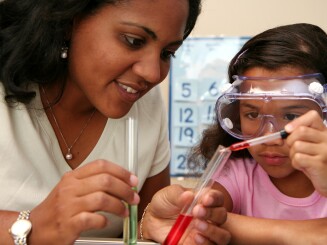- Home
- WISTEM2d youth
Encouraging budding STEM2D stars
To spark young people’s interest in STEM2D subjects, we need to reach them wherever they are—in urban centers, small towns, villages and rural communities. STEM2D must be accessible and available in a variety of places and settings. Everyone is welcome to join Johnson & Johnson’s WiSTEM2D programming and events.
We are committed to sparking enchantment with technology in young people through creative problem-solving and play all around the globe.
There are many ways to engage students, whether you want to help plan an event, share your career journey, present material in a school setting or organize a learning experience at your company.
Whether you’re a student exploring STEM2D or a parent, teacher or supporter, this page has tips, tools and resources to help you.
We are committed to sparking enchantment with technology in young people through creative problem-solving and play all around the globe.
There are many ways to engage students, whether you want to help plan an event, share your career journey, present material in a school setting or organize a learning experience at your company.
Whether you’re a student exploring STEM2D or a parent, teacher or supporter, this page has tips, tools and resources to help you.

Resources for parents, supporters and volunteers
To spark a lifelong interest in STEM²D and help inform young people about the endless possibilities of STEM, you can:
Model
Exposure to role models has been shown to improve performance on tests and to invalidate stereotypes.
Connect
All volunteers can greatly enrich their time with young people by sharing their own experiences.
Relate
Young people have unique social, personal and academic needs. Approach them with sincerity and respect.
Partnerships
To advance student outreach, Johnson & Johnson has partnered with leading nonprofit organizations to develop the youth STEM2D resources and website. Our STEM2D.org site contains STEM2D activities that can be completed by students of all ages at home, in the classroom, or in other small and large groups.

What is STEM2D?
It’s an acronym that refers to Science, Technology, Engineering, Mathematics, Manufacturing and Design.

Science
Observing, studying and experimenting to better understand the natural world and how it works.

Technology
Putting science and other knowledge to practical use to solve problems, invent useful tools, envision new possibilities and establish meaningful connections between people and the world that surrounds them.

Engineering
Applying science and math principles to design and develop products, structures, machines, tools or systems that help improve everyday life.

Mathematics
Using a quantitative framework (numbers, quantities, shapes, abstract principles and problem-solving) to describe the world.

Manufacturing
Creating something from raw materials by hand or by machinery.

Design
Developing human-centered, experiential solutions in collaboration with patients, consumers and experts from STEM and other disciplines to address unmet needs in a feasible, viable and desirable way.
More from Johnson & Johnson
Using your own cells to fight cancer
Cell therapy is bringing the world one step closer to eliminating cancer. Here’s how Johnson & Johnson is moving this cutting-edge therapy forward.
Moving toward a more personalized approach to treating depression
The World Health Organization predicts that depression will be the leading cause of disability across the globe by 2030. Learn how Johnson & Johnson is on a mission to change that.
“Our goal is a solution for every bladder cancer patient”
Meet Christopher Cutie, M.D., the Johnson & Johnson scientist who’s helping change the treatment landscape for people with bladder cancer, the tenth most common cancer in the world.


